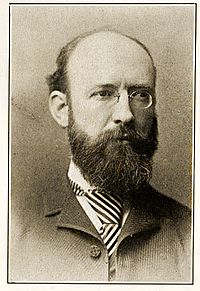John Walter Scott facts for kids
Quick facts for kids
John Walter Scott
|
|
|---|---|

Scott in 1877
|
|
| Born | November 2, 1845 |
| Died | January 4, 1919 (aged 73) |
| Nationality | American |
| Occupation | Engineer |
| Children | Walter Stone Scott |
| Engineering career | |
| Institutions | Collectors Club of New York American Philatelic Society |
| Projects | Created the first Scott catalog; conducted the first stamp auction; was America's first major stamp dealer |
| Awards | APS Hall of Fame |
John Walter Scott (born November 2, 1845, died January 4, 1919) was a very important person in the world of stamp collecting. He was born in England but moved to the United States to join the California Gold Rush.
He didn't find gold, so he started selling postage stamps to collectors. Soon, he became the top stamp dealer in America. Other stamp collectors called him "The Father of American Philately." This means he was a very important pioneer in stamp collecting in the U.S.
Contents
Scott's Stamp Publications
John Walter Scott made a big impact on stamp collecting through his writings. He helped collectors learn more about stamps.
First Stamp Magazine
In 1868, Scott started America's first important stamp magazine. It was called American Journal of Philately. This magazine helped connect stamp collectors.
The Famous Scott Catalog
Also in 1868, he created his first big stamp catalog. It was titled A Descriptive Catalogue of America and Foreign Postage Stamps, Issued from 1840 to Date. This catalog listed many stamps.
Over time, his Scott catalog became the main stamp catalog in the United States. It is still used by collectors today. In 1885, he sold his business rights to the Calman brothers. They renamed it the Scott Stamp and Coin Company.
Scott later started new stamp publications. These included The Metropolitan Philatelist and John W. Scott's Weekly Bulletin.
First Stamp Album
In 1869, Scott also made the first stamp album. This album had special spaces for stamps. It even included printed labels showing world leaders and himself.
Stamp Auctions by Scott
Scott was very creative in how he ran his business. He introduced new ways to sell stamps.
First Stamp Auction Ever
He held the very first postage stamp auction on May 28, 1870. This event took place in New York City. It was a big success.
Scott continued to organize and lead auctions in the United States and Europe. These auctions helped collectors buy and sell rare stamps.
Colorful Auction Catalogs
In 1882, Scott was the first to create an auction catalog with full-color pictures of the stamps. This made it easier for people to see what they were buying.
He was also the first person to sell a postage stamp for over one thousand dollars. This was a huge amount of money at the time for a single stamp.
Scott's Role in Stamp Collecting
Scott was very active in promoting the hobby of stamp collecting. He helped organize stamp shows and encouraged more people to join.
He was one of the people who helped start the Collectors Club of New York in 1896. He was also active in the American Philatelic Society. He served as its president from 1917 to 1919.
Scott's Lifestyle
John Walter Scott was also known for his personal choices. He followed a special diet.
Vegetarianism
Scott was a vegetarian. In 1910, it was noted that he had been a vegetarian for over 30 years. He also believed in not eating a midday meal.
He was the President of the New York Vegetarian Society.
Scott's Lasting Impact
John Walter Scott left a big mark on the world of stamp collecting. His work is still important today.
In 1941, he was added to the American Philatelic Society Hall of Fame. This honor recognizes people who have made major contributions to stamp collecting.
The Scott catalog is still widely used by American stamp collectors. Its continued use shows how important Scott's work was and how it continues to shape the hobby.
Images for kids



